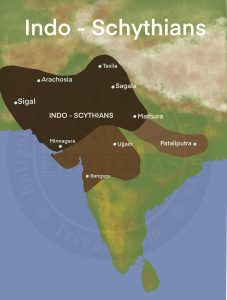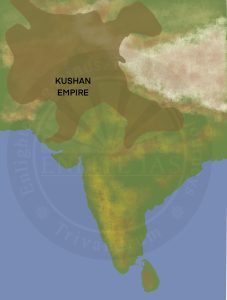Post Mauryan Period: North-Western India
Indo Greeks
- The term “Indo-Greeks” refers to several Hellenistic kingdoms that thrived in the Indian subcontinent from the second century BCE to the first century CE.
- During this period, the Greek and Indian cultures interacted, resulting in a unique mix of Hellenistic and Indian characteristics.
- Demetrius I was the first Indo-Greek emperor, followed by a succession of Indo-Greek monarchs, including Menander I, widely regarded as the greatest of all Indo-Greek kings.
- Menander I (165–145 BCE), also known as Milinda, was a Buddhist patron who was converted to Buddhism by Nagasena.
- The Indo-Greek monarchs were notable for their coinage, art, and architecture, which combined Greek and Indian influences.
- They were the first to mint gold coins.
- Decline – A variety of factors, including continual wars and disputes with neighbouring kingdoms, economic difficulties, and internal unrest, contributed to the Indo-Greek Kingdom’s gradual downfall.
- The Indo-Greek Kingdoms were primarily located in the northwestern regions of the Indian subcontinent, including present-day Afghanistan, Pakistan, and parts of northern India.
Sakas
- The Sakas were a group of nomadic people originally from Central Asia.
- They migrated into the northwestern parts of the Indian subcontinent during the 2nd century BCE.
- Maues is the Founder.
- Azes – I, son of Maues is the founder of the Vikram era.
- They are further divided into two-
- Indo-Scythians: The Sakas are sometimes identified with the Indo-Scythian dynasties that governed areas of northern India. Saka emperors established these dynasties, along with the Western Satraps.
- Western Satrapas: The Western Satrapas was a Saka dynasty that ruled across western India, including modern-day Gujarat and Maharashtra. Their rule coincided with an era of cultural and artistic exchange.
- Some of the Saka rulers supported Buddhism and other religions. They contributed to the construction of Buddhist stupas and monasteries.
- The most important ruler of Saka was Rudradaman.
- He repaired the Sudarsan Lake of the Mauryan Period.
- Details of it are mentioned in the Junagadh/ Girnar rock inscription in Gujarat.
- He issued the first ever long inscription in chaste Sanskrit.
Parthians
- The Parthians were from Iran and they replaced the Sakas in North-Western India. The most important ruler was Gondaphernes.

Kushana
- They belonged to the five Yeuchi clans of Central Asia.
- The founder was Kadphises I, also known as Kujula Kadhphises.
- Kanishka (78 CE – 101 CE), often known as ‘Second Ashoka’, is a well-known king.
- They succeeded the Parthians in North-Western India, then spread to the lower Indus basin and upper and middle Gangetic basins. They controlled the well-known silk route. This route was a big source of cash for them.
- They were the first kings in India to produce gold coins in large numbers.
- Kanishka established a period in 78 CE that is today known as the Saka era and is officially used by the Government of India.
- His capital was at Peshawar.
- Kanishka was a huge supporter of Mahayana Buddhism. During his reign, the 4th Buddhist council was held in Kundalavana, Kashmir, when the doctrines of the Mahayana school of Buddhism were finalized.
- A large, headless figure of Kanishka has been discovered in Mathura.
- Kanishka patronized many scholars, including Nagarjuna, Ashvagosha, Vasumitra, Parsava, Chakra, and Mathara.
- Art and Architecture
- The Gandhara School of Art rose to prominence during the Kushan period. This school arose in the Gandhara region (modern-day northwest Pakistan and eastern Afghanistan) and was heavily inspired by Greco-Roman artistic forms. Gandhara art is distinguished by Hellenistic aspects such as realistic human forms, drapery, and idealised representations of Buddha.
- Mathura School of Art: The Kushan Empire, like Gandhara, saw the emergence of the Mathura School of Art. The Mathura region (in modern-day Uttar Pradesh, India) became a hub for religious and cultural activities. Mathura art centred on Hindu deities such as Vishnu, Shiva, and Devi. Sculptures from this school exhibited a more indigenous Indian style, with softer features and a sense of movement.
- Stone Sculptures: Stone sculptures were a popular form of artistic expression throughout the Kushana Age. Artists expertly crafted sculptures from many types of stone, including grey schist and mottled red sandstone. These sculptures decorated temples, stupas, and other architectural monuments.
- Architectural Innovations: The Kushanas pioneered architectural innovation, particularly in temple architecture. They constructed enormous and complex temples, sometimes having a square sanctuary and a pillared mandapa (assembly hall) in front. The temples featured distinctive ornamentation, including carved friezes, toranas (arched gates), and ornate patterns.
- Coinage: The Kushanas were famous for their elaborate coinage, which reflected artistic and cultural influences. The coins included pictures of monarchs, goddesses, and numerous symbols. These coins provide important insights into the iconography and artistic trends of the time.

Kanishka
- Kanishka was the most important ruler of the Kushana dynasty.
- He was the founder of the Saka era which started in 78 CE.
- He was not only a great conqueror but also a patron of religion and art.
- Kanishka and Buddhism
- During the early years of his reign, Kanishka adopted Buddhism.
- His coins feature images of various gods, including Buddha, Greek, and Hindu. It reflects Kanishka’s tolerance for other religions.
- During the Kanishka era, Mahayana Buddhism gained popularity. This religion differs significantly from that of the Buddha and Asoka.
- Kanishka also dispatched missionaries to Central Asia and China to spread the new faith. Buddhist chaityas and viharas were erected in diverse places.
- He patronised Buddhist scholars such as Vasumitra, Asvagosha, and Nagarjuna. He organised the Fourth Buddhist Council to discuss Buddhist theology which was conducted under the presidency of Vasumitra.
- The Council created an authorised interpretation on the Tripitakas, and the Mahayana doctrine was finalised.

